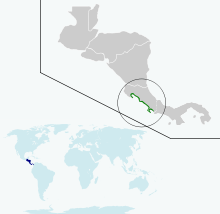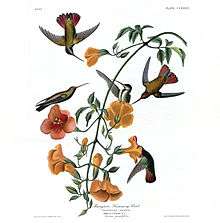Mangrove hummingbird
The mangrove hummingbird (Amazilia boucardi) is a species of hummingbird in the family Trochilidae. It is found only in Costa Rica. Its natural habitat is subtropical or tropical mangrove forest. It is threatened by habitat loss. The mangrove hummingbird feeds primarily on nectar from the flowers of the tea mangrove Pelliciera rhizophorae. Mangrove hummingbirds are occasionally seen in adjacent non-mangrove habitats. Nesting for these birds has been recorded during the months of October through February. The mangrove hummingbird is on average approximately 10 cm (3.9 in) long.
| Mangrove hummingbird | |
|---|---|
 | |
| Scientific classification | |
| Kingdom: | Animalia |
| Phylum: | Chordata |
| Class: | Aves |
| Order: | Apodiformes |
| Family: | Trochilidae |
| Genus: | Amazilia |
| Species: | A. boucardi |
| Binomial name | |
| Amazilia boucardi Mulsant, 1877 | |
 | |
| Range | |
| Synonyms[2] | |
|
Polyerata boucardi | |
Description
The average bird is approximately between 9.5 and 11 cm (3.7 and 4.3 in) and weighs around 4.5 g (0.2 oz). The bill of an adult averages 18 mm (0.7 in) in length. . Bronze and green in color. The male is pale green on his crown and upperparts, with bronze tinge to his rear with his tail being a bronze-green color. They have dark bills with reddish lower mandible. Females are similar looking with mainly white underparts and little green spotting on throat and sides.[3]
Behaviour
The mangrove hummingbird primarily feeds off the nectar from the flowers of the tea mangrove (Pelliciera rhizophorae). It also takes nectar from several other species of plant and feeds on insects. The tiny cup-shaped nest is made from fluff from the balsa tree (Ochroma pyramidale), lichens and cobwebs. It is built in the branches of the tea mangrove a few metres above the water. Two eggs are laid between October and February and incubated by the female.[4]
Status

The current population of the mangrove hummingbird (2012) is estimated to be between 2,500 and 10,000 birds and declining.[5]
These hummingbirds first became threatened in 1988, in 1994-1996 they were classified as Vulnerable, and in 2000 until present, they are considered endangered. Habitat destruction is reducing and severely damaging the mangrove hummingbirds natural very small habitat in the first place, resulting in endangerment. The construction of Salinas and shrimp ponds and selective logging for charcoal production are destroying the mangroves, the natural habitat of these hummingbirds. Other threats include illegal cutting, road construction, and pollution. Remaining population estimate about 2,500-9,999 mature individuals with population decreasing. With these threats to its already severely fragmented habitat, the IUCN has listed it as "Endangered". It is listed in CITES Appendix II which makes trade in this hummingbird illegal without a permit. Cutting mangroves in Costa Rica is also illegal, but this law is widely disregarded.[1]
See also
References
- BirdLife International (2012). "Amazilia boucardi". IUCN Red List of Threatened Species. 2012. Retrieved 26 November 2013.CS1 maint: ref=harv (link)
- "Amazilia boucardi". Avibase.
- Luther, David (2009). "Mangrove Hummingbird (Amazilia boucardi)". Neotropical Birds Online. Retrieved 2013-12-21.
- Luther, David (2009). "Mangrove Hummingbird: Life history (Amazilia boucardi)". Neotropical Birds Online. Retrieved 2013-12-21.
- "Species factsheet: Amazilia boucardi". BirdLife International. Retrieved 2013-12-21.
